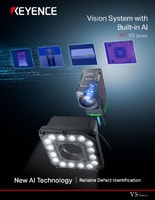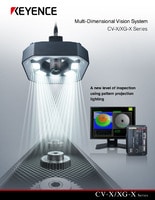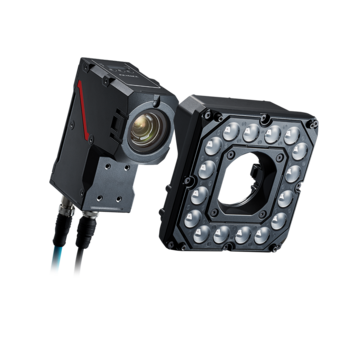Vision Systems
- Vision System with Built-in AI VS series
- Intuitive Vision System CV-X series
- Customizable Vision System XG-X series
- GigE camera and lighting for PC-based machine vision VJ series
- Inline 3D Inspection 3D Vision series
- 3D Vision-Guided Robotics 3D VGR series
- Line Scan Technology Line Scan series
- 2D Vision-Guided Robotics 2D VGR series
- LED Lighting CA-D series
- Lenses (for Machine Vision) CA-L series
- Machine Vision System Database VisionDatabase series
- Automotive
- Automation Equipment/Machine Building
- Electric Vehicles
- Medical Device Manufacturing
- Food/Beverage Packaging
- Semiconductor/Manufacturing Electronics
- Vision-Guided Robotics
- Solar
- Logistics
- Commodities
- Paper Manufacturing
- Machine Tools
- Electronic Device
- Printing
- Mining/Metals
- Fabric/Textile
- Tobacco
- Marine
- Aerospace
Key Differences Between 2D and 3D Vision Systems

Machine vision systems aren’t a novelty since the technology dates back to the 1950s. However, just like any other cutting-edge technology, it was exorbitantly expensive. Thus, vision systems were available only to the select few organizations that found financial viability in vision system implementation.
Fortunately, the advent of technology made vision systems more advanced and affordable to medium- and small-sized businesses and even consumers. Furthermore, the technology evolved from single-beam 1D laser triangulation to 2D vision and, most recently, 3D vision systems.
As a result, 2D and 3D vision systems are now much more common in modern industry. Thanks to the advancements in AI and machine learning technology and their subsequent and continued integration, these vision systems aren’t just here to stay—they’re effectively carrying us into the next industrial age.
But what exactly are the key differences between 2D and 3D vision systems? Do they work on different principles? What are their applications? Before answering those questions, let’s familiarize ourselves with what 2D and 3D vision systems are.
What Is a 2D Vision System?
2D vision systems are often used in manufacturing and other industrial settings for quality control, automation, and identification applications, as well as measuring the physical properties of an observed object. As such, these vision systems rely on a range of different sensors and cameras, as well as machine learning and computer algorithms, to process captured data.
As their name implies, 2D vision systems capture data in two dimensions, typically length and width measurements—along the x and y axis—by relying on CCD or CMOS cameras. However, these vision systems are also used for measuring different physical properties, such as temperature, surface roughness, and overall surface profiling.
Unfortunately, certain limitations are associated with 2D vision systems, and the absence of height/depth detection is one of them. They’re also great for the identification of objects that are separately arranged in a plane, which limits their flexibility.
Lastly, certain applications are known for their high light dependency because shadows cast by the object might give the object a new contour, which leads to errors in particular applications. So, while they’re relatively inexpensive and great for surface-area checking, bar-code reading, label verification, and basic quality inspection, they’re not best suited for applications that are extremely difficult to light.
More advanced applications demand the use of 3D vision systems.
We’re here to provide you with more details.
Reach out today!

What Is a 3D Vision System?
Unlike 2D vision systems, which only capture data in two dimensions, 3D vision systems can also collect height/depth data from the surface of the object to accurately digitize the object’s shape and present it in a digital, three-dimensional format.
Traditionally, 3D scanning has been done by using coordinate-measuring machines, which rely on physical contact with the object from which to derive data. As such, these methods were quite slow and very limited in terms of what they could do.
3D vision systems, on the other hand, excel at fast and accurate data collection, and despite being a novelty, they are revolutionizing numerous industries, particularly in applications that are too complex for 2D vision systems.
This implies that 3D vision systems are more complex and resource-intensive than 2D technologies. While true, these systems compensate with their sheer capabilities, backed by advanced 3D algorithms, multi-core processors, and software tools that enhance their capabilities across multiple applications.
3D vision systems rely on a variety of sensors to collect data, including stereo vision industrial 3D cameras, structured light sensors, time-of-flight cameras, LIDAR, photogrammetry, and even multiple 2D/3D laser profilers to capture images and process them to derive depth information crucial for understanding object shape, and its position in space.
Curious about our pricing?
Click here to find out more.

Key Features and Characteristics of KEYENCE 3D Vision Systems
Advanced 3D Depth Mapping Technology
KEYENCE 3D machine vision systems go beyond traditional 2D imaging to capture extremely detailed three-dimensional views of objects. Instead of detecting only contrast and edges, as a 2D machine vision system does, they use structured light and laser profiling to measure depth precisely. This makes them ideal for detecting minor surface flaws, verifying complex assemblies, and guiding robots with accuracy.
Precision and Accuracy of KEYENCE 3D Vision Systems
KEYENCE 3D vision systems can measure down to the micron level, capturing even the smallest details. These systems provide reliable, consistent measurements thanks to high-resolution sensors and smart algorithms that filter out noise, whether checking for tiny defects or ensuring parts fit together perfectly. This level of accuracy helps manufacturers reduce false positives and increase overall efficiency.
Integration with KEYENCE’s Other Vision Solutions
KEYENCE makes it easy to combine 3D and 2D vision for a complete inspection setup. With seamless integration, manufacturers can handle everything from barcode reading and pattern matching (with 2D vision) to depth measurement and contour analysis (with 3D vision). A hybrid approach boosts automations, making it simple to upgrade to more advanced, high-precision analysis.
Industry-Specific Features of KEYENCE 3D Vision Systems
KEYENCE designs 3D vision systems for many use cases. Automotive manufacturers achieve perfect welds and precise gap measurements. In electronics, solder joints are analyzed with high accuracy.
Packaging companies use them to ensure label placement and seal integrity, whereas pharmaceutical manufacturers use them to verify blister packs and vials. Whatever the industry, these systems provide the tailored solutions required for high-quality production.
How to Choose Between 2D and 3D Vision Systems for Your Application
Factors to Consider When Choosing Between 2D and 3D
The right vision system depends on your needs—2D is great for flat surface and straightforward inspections, while 3D is essential for depth measurement and complex shapes. Think about your production speed, lighting environment, and how the system will integrate before deciding.
When to Choose a 2D Vision System
A 2D vision system is ideal for tasks that involve reading barcodes, checking labels, verifying printed text (OCR), or spotting defects based on contrast differences. These systems are affordable, easy to set up, and work well for many standard inspection processes where depth information isn’t necessary.
When to Choose a 3D Vision System
If your application involves measuring depth, height, or complex shapes, 3D machine vision is the ideal solution. Widely used in industries like automotive and aerospace for high-precision part inspections, 3D systems excel in electronics for solder joint analysis, and in packaging for quality control. Robotic systems also depend on 3D vision for precise pick-and-place operations.
Cost Considerations for 2D vs 3D Vision Systems
2D vision systems usually cost less upfront and are easier to set up, making them a good choice for simple inspection jobs. On the other hand, 3D vision systems require a bigger initial investment but offer better accuracy, which helps cut down on defects and boosts overall quality control. In the long run, the return on investment for a 3D system often makes the expense worth it for manufacturers working with high-precision parts or complicated assemblies.
Case Studies: Success Stories for 2D and 3D Vision Systems
Automotive manufacturers inspect over 30,000 parts per vehicle, and manual checks just aren’t fast or reliable enough. Errors lead to inefficiencies, defects, and costly rework.
KEYENCE vision systems improved quality control, enabling rapid, precision-driven inspections that automatically detect defects and track component histories. This technology drives operational excellence by ensuring uncompromising quality and streamlining production processes.
Industry-Specific Applications of 2D and 3D Machine Vision Technology
As stated above, both 2D and 3D machine vision have revolutionized numerous industries and become vital to their most crucial operations. However, they’re not interchangeable; each system offers unique capabilities best suited for specific applications.
For example, 2D and 3D vision systems are used in manufacturing industries. However, 2D vision systems are mostly used for quality control, defect detection, dimensional accuracy, surface finish detection, bar-code reading, and welding robot guidance.
3D machine vision systems are often used to help align and assemble complex parts with exceptionally high accuracy and perform 3D inspection of products, ensuring they meet the strict manufacturing requirements.
The automotive industry is perhaps the best example of 2D and 3D vision systems used in manufacturing, where 2D systems ensure that the right parts are used in the correct stages of assembly, while 3D vision systems complete accurate assembly of car body parts.
2D and 3D vision systems aren't limited to the automotive industry alone. These systems are commonly employed in electronics, healthcare, pharmaceuticals, food and beverage industries, logistics, and warehousing.
In other words, 2D vision systems are primarily used in surface-level inspections and measurements, while 3D vision systems are mainly used in applications that require depth perception and complex spatial understanding.
Contact us to learn more about how our advanced technology can help take your business to the next level.
Contact Us
FAQs about 2D and 3D Vision Systems
What Are the Advantages of 2D and 3D Vision Systems?
Both 2D and 3D vision systems offer their advantages depending on the application. Both systems offer precise and accurate measurements down to a µm range, as well as fast and reliable operation.
Individually speaking, 2D systems are generally more affordable and less complex than 3D vision systems, but they’re also more limited in their operational capacity—they can’t be integrated into operational processes that require depth perception.
That’s where 3D vision systems come in. Not only are they capable of conducting precise measurements and inspections, but their µm-range accuracy allows them to streamline defect checks, enable more precise robot guidance, and aid object recognition.
However, they’re quite complex; they often rely on multiple sensors and complex algorithms that enable image processing and spatial recognition—all of which ultimately affect and justify a higher price tag.
When Should You Choose a 2D Vision System Over a 3D Vision System, and Vice Versa?
2D and 3D vision systems both have their advantages and drawbacks, which make them better suited for some applications and not others. Choosing one over the other ultimately comes down to your application-specific requirements, which make one type of vision system better suited than the other.
For example, picking items from a bin via robot requires the use of 3D vision systems, as parts in the bin can be placed at random and at different heights.
However, the high speed and relative accuracy of 2D vision systems make them useful in applications such as surface defect detection, barcode scanning, discoloration, and more.
How Does the KEYENCE 3D Vision System Improve Inspection Efficiency?
KEYENCE 3D vision systems automate precise depth and dimensional measurements, reducing manual errors and speeding up the process for higher production rates. It ensures consistent quality by capturing detailed surface profiles and integrating seamlessly with other KEYENCE vision solutions.
If you're not sure which type of vision system would be better suited for your application, KEYENCE can help! Contact us today to learn more about our state-of-the-art 2D and 3D vision systems and how they can benefit your specific needs.
We’re here to provide you with more details.
Reach out today!

Related Downloads
Related Products
Industries
- Automotive
- Automation Equipment/Machine Building
- Electric Vehicles
- Medical Device Manufacturing
- Food/Beverage Packaging
- Semiconductor/Manufacturing Electronics
- Vision-Guided Robotics
- Solar
- Logistics
- Commodities
- Paper Manufacturing
- Machine Tools
- Electronic Device
- Printing
- Mining/Metals
- Fabric/Textile
- Tobacco
- Marine
- Aerospace







